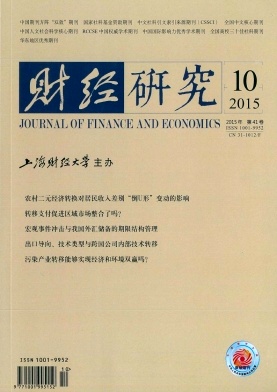劳动收入份额“U形”演变规律的新解释:要素禀赋结构与技术进步方向的视角
财经研究 2015 年 第 41 卷第 10 期, 页码:
摘要
参考文献
摘要
当前劳动收入份额的持续下降已引发社会各界的广泛关注,现有文献更多地从产业结构、制度和劳动者谈判力等角度展开分析,相关观点对某一特定经济体的劳动收入份额变化有着较强的解释力,却无法诠释世界范围内劳动收入占比的下降。为此,文章从要素禀赋结构和技术进步偏向性视角重新审视劳动收入份额演变的成因,采用供给面三方程标准化系统方法测算了全国及各地区技术进步偏向性指数。结果显示,中国的技术进步整体上呈现资本偏向性,即更有助于提高资本边际产出而恶化劳动收入分配地位。文章进一步采用面板数据门限回归方法检验了要素禀赋结构、技术进步方向与劳动收入份额的关系。研究发现,要素禀赋结构对技术进步方向的影响存在门限效应,决定了劳动收入份额的U形演变规律,即劳动收入份额随劳均资本的增加呈先下降后上升的趋势,转折阈值约为6.381万元;我国多数地区处于U形走势左侧,只有部分地区跨越了门限值而进入到劳动收入份额上升通道。因此,若要有效抑制劳动收入份额的下降,应关注要素禀赋结构和技术进步方向的影响。
[1]白重恩,钱震杰.国民收入的要素分配:统计数据背后的故事[J].经济研究,2009,(3):27-41.
[2]白雪梅.教育与收入不平等:中国的经验研究[J].管理世界,2004,(6):53-58.
[3]戴天仕,徐现祥.中国的技术进步方向[J].世界经济,2010,(11):54-70.
[4]董直庆,安佰珊,张朝辉.劳动收入占比下降源于技术进步偏向性吗?[J].吉林大学社会科学学报,2013,(4):65-74.
[5]郭庆旺,吕冰洋.论要素收入分配对居民收入分配的影响[J].中国社会科学,2012,(12):46-62.
[6]李稻葵,刘霖林,王红领.GDP中劳动份额演变的U型规律[J].经济研究,2009,(1):70-82.
[7]罗长远,张军.经济发展中的劳动收入占比:基于中国产业数据的实证研究[J].中国社会科学,2009,(4):65-79.
[8]王林辉,韩丽娜.技术进步偏向性及其要素收入分配效应[J].求是学刊,2012,(1):56-62.
[9]王忠,黄佳祥,黎富森.人力资本积累与劳动收入份额:一个新的解释[J].北京工业大学学报(社会科学版),2013,(5):31-37.
[10]张军,吴桂英,张吉鹏.中国省级物质资本存量估算:1952-2000[J].经济研究,2004,(10):35-44.
[11]Acemoglu D. Labor and capitalaugmenting technical change[R]. NBER Working Paper No.7544,2000.
[12]Acemoglu D. Equilibrium bias of technology[J]. Econometrica, 2007, 75(5): 1371-1409.
[13]Bentolila S, SaintPaul G. Explaining movements in the labor share[J]. The BE Journal of Macroeconomics, 2003, 3(1): 1-33.
[14]Blanchard O J, Nordhaus W D, Phelps E S. The medium run[J]. Brookings Papers on Economic Activity, 1997,1997(2): 89-158.
[15]Blanchard O, Giavazzi F. Macroeconomic effects of regulation and deregulation in goods and labor markets[J]. Quarterly Journal of Economics, 2003, 118(3): 879-907.
[16]David P A, Van de Klundert T. Biased efficiency growth and capitallabor substitution in the US, 1899-1960[J]. American Economic Review, 1965, 55(3): 357-394.
[17]Daudey E, GarcíaPealosa C. The personal and the factor distributions of income in a crosssection of countries[J]. Journal of Development Studies, 2007, 43(5): 812-829.
[18]Decreuse B, Maarek P. FDI and the labor share in developing countries: A theory and some evidence[R]. University Library of Munich, 2008.
[19]Diwan I. Debt as sweat: Labor, financial crises, and the globalization of capital[R]. Working Paper, The World Bank, 2001.
[20]Giovannoni O. Functional distribution of income, inequality and the incidence of poverty: Stylized facts and the role of macroeconomic policy[R]. Background Paper for UNRISD Report on Combating Poverty and Inequality, 2008.
[21]Goldsmith R W. A perpetual inventory of national wealth[A]. NBER. Studies in income and wealth(Volume 14)[C].NBER, 1951.
[22]Harrison A E. Has globalization eroded labor’s share? Some crosscountry evidence[R]. University Library of Munich,2005.
[23]Hicks J R. The theory of wages[M]. London: Macmillan, 1932.
[24]Kaldor N. A model of economic growth[J]. Economic Journal, 1957,67(268): 591-624.
[25]Karabarbounis L, Neiman B. Capital depreciation and labor shares around the world: Measurement and implications[R]. NBER Working Paper No.20606, 2014.
[26]Klump R, McAam P, Willman A. Factor substitution and factoraugmenting technical progress in the United States: A normalized supplyside system approach[J]. Review of Economic and Statistic, 2007, 89(1): 183-192.
[27]Pick J B, Nishida T. Digital divides in the world and its regions: A spatial and multivariate analysis of technological utilization[J]. Technological Forecasting and Social Change, 2015, 91: 1-17.
[28]Sato R, Morita T. Quantity or quality: The impact of labour saving innovation on US and Japanese growth rates, 1960-2004[J]. Japanese Economic Review, 2009, 60(4): 407-434.
[29]Zuleta H. Factor saving innovations and factor income shares[J]. Review of Economic Dynamics, 2008, 11(4): 836-851.
[2]白雪梅.教育与收入不平等:中国的经验研究[J].管理世界,2004,(6):53-58.
[3]戴天仕,徐现祥.中国的技术进步方向[J].世界经济,2010,(11):54-70.
[4]董直庆,安佰珊,张朝辉.劳动收入占比下降源于技术进步偏向性吗?[J].吉林大学社会科学学报,2013,(4):65-74.
[5]郭庆旺,吕冰洋.论要素收入分配对居民收入分配的影响[J].中国社会科学,2012,(12):46-62.
[6]李稻葵,刘霖林,王红领.GDP中劳动份额演变的U型规律[J].经济研究,2009,(1):70-82.
[7]罗长远,张军.经济发展中的劳动收入占比:基于中国产业数据的实证研究[J].中国社会科学,2009,(4):65-79.
[8]王林辉,韩丽娜.技术进步偏向性及其要素收入分配效应[J].求是学刊,2012,(1):56-62.
[9]王忠,黄佳祥,黎富森.人力资本积累与劳动收入份额:一个新的解释[J].北京工业大学学报(社会科学版),2013,(5):31-37.
[10]张军,吴桂英,张吉鹏.中国省级物质资本存量估算:1952-2000[J].经济研究,2004,(10):35-44.
[11]Acemoglu D. Labor and capitalaugmenting technical change[R]. NBER Working Paper No.7544,2000.
[12]Acemoglu D. Equilibrium bias of technology[J]. Econometrica, 2007, 75(5): 1371-1409.
[13]Bentolila S, SaintPaul G. Explaining movements in the labor share[J]. The BE Journal of Macroeconomics, 2003, 3(1): 1-33.
[14]Blanchard O J, Nordhaus W D, Phelps E S. The medium run[J]. Brookings Papers on Economic Activity, 1997,1997(2): 89-158.
[15]Blanchard O, Giavazzi F. Macroeconomic effects of regulation and deregulation in goods and labor markets[J]. Quarterly Journal of Economics, 2003, 118(3): 879-907.
[16]David P A, Van de Klundert T. Biased efficiency growth and capitallabor substitution in the US, 1899-1960[J]. American Economic Review, 1965, 55(3): 357-394.
[17]Daudey E, GarcíaPealosa C. The personal and the factor distributions of income in a crosssection of countries[J]. Journal of Development Studies, 2007, 43(5): 812-829.
[18]Decreuse B, Maarek P. FDI and the labor share in developing countries: A theory and some evidence[R]. University Library of Munich, 2008.
[19]Diwan I. Debt as sweat: Labor, financial crises, and the globalization of capital[R]. Working Paper, The World Bank, 2001.
[20]Giovannoni O. Functional distribution of income, inequality and the incidence of poverty: Stylized facts and the role of macroeconomic policy[R]. Background Paper for UNRISD Report on Combating Poverty and Inequality, 2008.
[21]Goldsmith R W. A perpetual inventory of national wealth[A]. NBER. Studies in income and wealth(Volume 14)[C].NBER, 1951.
[22]Harrison A E. Has globalization eroded labor’s share? Some crosscountry evidence[R]. University Library of Munich,2005.
[23]Hicks J R. The theory of wages[M]. London: Macmillan, 1932.
[24]Kaldor N. A model of economic growth[J]. Economic Journal, 1957,67(268): 591-624.
[25]Karabarbounis L, Neiman B. Capital depreciation and labor shares around the world: Measurement and implications[R]. NBER Working Paper No.20606, 2014.
[26]Klump R, McAam P, Willman A. Factor substitution and factoraugmenting technical progress in the United States: A normalized supplyside system approach[J]. Review of Economic and Statistic, 2007, 89(1): 183-192.
[27]Pick J B, Nishida T. Digital divides in the world and its regions: A spatial and multivariate analysis of technological utilization[J]. Technological Forecasting and Social Change, 2015, 91: 1-17.
[28]Sato R, Morita T. Quantity or quality: The impact of labour saving innovation on US and Japanese growth rates, 1960-2004[J]. Japanese Economic Review, 2009, 60(4): 407-434.
[29]Zuleta H. Factor saving innovations and factor income shares[J]. Review of Economic Dynamics, 2008, 11(4): 836-851.
引用本文
王林辉, 赵 景, 李金城. 劳动收入份额“U形”演变规律的新解释:要素禀赋结构与技术进步方向的视角[J]. 财经研究, 2015, 41(10): 0.
导出参考文献,格式为:





 8855
8855  4292
4292

